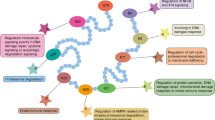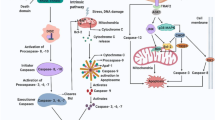Abstract
During our search for novel transformation-sensitive proteins whose synthesis is abolished in tumour cells we found a cDNA clone coding for tissue transglutaminase. This enzyme was identified, at the protein as well as the mRNA level, in normal human fibroblasts, but was completely missing in their matched SV40 transformed counterparts. Since tissue transglutaminase has been implicated in cell cycle regulation and apoptosis, we investigated the possibility of whether this enzyme might represent a negative marker for tumour cells. We found that its synthesis varied largely among 10 cell lines derived from spontaneous mesenchymal tumours. While cells from a rhabdomyosarcoma and a chondrosarcoma did not produce it at all, an extremely high expression was observed in cells from an osteosarcoma and a liposarcoma. Thus, tissue transglutaminase is not a tumour-related marker.
Similar content being viewed by others
References
Schenker T, Lach C, Kessler B, Calderara S, Trueb B. A novel GTP-binding protein which is selectively repressed in SV40 transformed fibroblasts.J Biol Chem 1994:269: 25447–25453.
Rowe DW, Moen RC, Davidson JM, Byers H, Bornstein P, Palmiter RD. Correlation of procollagen mRNA levels in normal and transformed chick embryo fibroblasts with different rates of procollagen synthesis.Biochemistry 1978:17: 1581–1590.
Sambrook J, Fritsch EF, Maniatis T.Molecular Cloning: a Laboratory Manual. Cold Spring Harbor, NY: Cold Spring Harbor Laboratory Press, 1989.
Feinberg A, Vogelstein B. A technique for radiolabeling DNA restriction endonuclease fragments to high specific activity.Anal Biochem 1983;132: 6–13.
Sanger F, Nicklen S, Coulson AR. DNA sequencing with chainterminating inhibitors.Proc Natl Acad Sci USA 1977;74: 5463–5467.
Lowry OH, Rosebrough NJ, Farr AL, Randall RJ. Protein measurement with the folin phenol reagent.J Biol Chem 1951;193: 265–275.
Laemmli UK. Cleavage of structural proteins during the assembly of the head of bacteriophage T4.Nature 1970;227: 680–685.
Towbin H, Staehelin T, Gordon J. Electrophoretic transfer of proteins from polyacrylamide gels to nitrocellulose sheets: procedure and some applications.Proc Natl Acad Sci USA 1979;76: 4350–4354.
Trueb B, Bornstein P. Characterization of the precursor form of type VI collagen.J Biol Chem 1984;259: 8597–8604.
Birckbichler J, Upchurch HF, Patterson MK Jr, Conway E. A monoclonal antibody to cellular transglutaminase.Hybridoma 1985;4: 179–186.
Harlow E, Lane D.Antibodies, a Laboratory Manual. Cold Spring Harbor, NY: Cold Spring Harbor Laboratory Press, 1988.
Lorand L, Campbell-Wilkes LK, Cooperstein L. A filter paper assay for transamidating enzymes using radioactive amine substrates.Anal Biochem 1972;50: 623–631.
Aeschlimann D, Paulsson M. Transglutaminases: protein crosslinking enzymes in tissues and body fluids.Thromb Haemostasis 1994;71: 402–415.
Greenberg CS, Birckbichler J, Rice RH. Transglutaminases: multifunctional cross-linking enzymes that stabilize tissues.FASEB J 1992;5: 3071–3077.
Nakaoka H, Perez DM, Baek KJ,et al. Gh: a GTP-binding protein with transglutaminase activity and receptor signaling function.Science 1994;264: 1593–1596.
Knight CRL, Rees RC, Griffin M. Apoptosis: a potential role for cytosolic transglutaminase and its importance in tumour progression.Biochim Biophys Acta 1991;1096: 312–318.
Knight CRL, Rees RC, Elliott BM, Griffin M. The existence of an inactive form of transglutaminase within metastasising tumours.Biochim Biophys Acta 1990;1053: 13–20.
Johnson TS, Knight CRL, El-Alaoui S,et al. Transfection of tissue transglutaminase into a highly malignant hamster fibrosarcoma leads to a reduced incidence of primary tumour growth.Oncogene 1994;9: 2935–2942.
Melino G, Annicchiarico-Petruzzelli M, Piredda L, Candi E, Gentile V, Davies JA, Piacentini M. Tissue transglutaminase and apoptosis: sense and antisense transfection studies with human neuroblastoma cells.Mol Cell Biol 1994;14: 6584–6596.
Takaku K, Futamura M, Saitoh S, Takeuchi Y. Tissue-type transglutaminase is not a tumour-related marker.J Biochem 1995;118: 1268–1270.
Beninati S, Abbrezzese A, Cardinali M. Differences in the post-translational modification of proteins by polyamines between weakly and highly metastatic B16 melanoma cells.Int J Cancer 1993;53: 792–797.
Hand D, Elliot BM, Griffin M. Expression of the cytosolic and the particulate forms of transglutaminase during chemically induced rat liver carcinogenesis.Biochim Biophys Acta 1988;970: 137–145.
Birckbichler J, Orr GR, Patterson MK Jr, Conway E, Carter HA. Increase in proliferative markers after inhibition of transglutaminase.Proc Natl Acad Sci USA 1988;78: 5005–5008.
Birckbichler J, Patterson MK Jr. Cellular transglutaminase, growth, and transformation.Ann NY Acad Sci 1978;312: 354–365.
Van Groningen JJM, Klink SL, Bloemers HPJ, Swart GWM. Expression of tissue-type transglutaminase correlates positively with metastatic properties of human melanoma cell lines.J Cancer 1995;60: 383–387.
Author information
Authors and Affiliations
Additional information
This study was supported by grants from the ETH Zurich (0-20-854-94) and from the Swiss National Science Foundation (31-40337.94).
Rights and permissions
About this article
Cite this article
Schenker, T., Trueb, B. Tissue transglutaminase in mesenchymal tumour cells. Apoptosis 1, 126–130 (1996). https://doi.org/10.1007/BF01321018
Received:
Accepted:
Issue Date:
DOI: https://doi.org/10.1007/BF01321018




